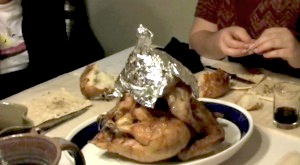French – Class Project: Repas Médiéval
French Major Alysha Summers describes her experience in the Senior Seminar class she took with Prof. Tim Tomasik.
 “I was enrolled in the French Senior Seminar titled “French Gastronomies. This course was designed to create an appreciation and understanding of the progression of French cuisine through class discussion, various texts, and extracurricular group dinners. The basis for these dinners, or travaux pratiques, were menus we had encountered in our readings which assisted us in creating and sampling the different tastes of the four time periods that we studied. These eras were The Middle Ages, the 17th-18th century, the 19th century, and the 20th century. Creating meals based on the foods we envisioned from our readings was quite interesting. All epochs provided new tastes (some more memorable than others), but also offered my fellow class members the chance to apply their knowledge the culinary experience in a setting other than the classroom.
“I was enrolled in the French Senior Seminar titled “French Gastronomies. This course was designed to create an appreciation and understanding of the progression of French cuisine through class discussion, various texts, and extracurricular group dinners. The basis for these dinners, or travaux pratiques, were menus we had encountered in our readings which assisted us in creating and sampling the different tastes of the four time periods that we studied. These eras were The Middle Ages, the 17th-18th century, the 19th century, and the 20th century. Creating meals based on the foods we envisioned from our readings was quite interesting. All epochs provided new tastes (some more memorable than others), but also offered my fellow class members the chance to apply their knowledge the culinary experience in a setting other than the classroom.
The most memorable travaux pratique (we’re still trying to get the taste of liver out of our mouths!) was the meal for the Middle Ages. After starting out with grapes, toast and saucisson sec, we continued our medieval meal with a liver and onion plate. This is not the typical vinaigrette!
After this we moved onto the main service. In this course, we encountered some interesting new tastes. The blancmanger was a mixture of ground chicken, rice, milk, and salt. It was topped with pomegranate seeds that were laboriously obtained, and also topped with slivered almonds. These toppings allowed the dish to have both a sweet and savory taste. Also included in the main course was ‘chapon rôti et coquelet héaumé’, which essentially was a Cornish hen placed on top of an entire chicken and – decorated with tin foil to create the appearance of a jousting knight. To accompany the chapon, we created three sauces: Cameline (cinnamon based), jance, and poitevine (liver based).
To finish the meal, we created both a traditional dessert course involving an almond flan and larded milk. However, this was not the end of the meal as we also produced a “boutehors” to cleanse the palette. “Boutehors” literally means “to kick outside”, and was traditionally consumed as the host was saying his goodbyes.
Although this meal was not what many think to be stereotypically French, as the semester continued, our menus included more recognizable foods. Preparation of these recipes also became easier, as specific directions regarding amount or cook time that were lacking in the earlier epochs, appeared in later texts.”